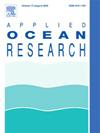Analysis and experimental research on the coupled motion of the foot and paddle of crab-like robot based on biological observation
IF 4.3
2区 工程技术
Q1 ENGINEERING, OCEAN
引用次数: 0
Abstract
Shallow water regions, characterized by complex and varied terrain as well as dense aquatic vegetation, pose challenges for traditional propeller-based propulsion systems, which can damage seabed substrates and become entangled with aquatic plants. Amphibious bionic robots, with their remarkable environmental adaptability, have emerged as a research focus for operations in shoal environments. Drawing inspiration from the walking behavior of Portunus trituberculatus (Portunus), this paper presents a walking method for a crab-like robot that incorporates a coupled foot-paddle motion. Using the direct linear transformation (DLT) algorithm, we have captured the motion trajectories of the swimming paddles (in both heart-shaped and figure-eight patterns) during the underwater locomotion of Portunus. A hydrodynamic simulation environment was established, and the robot model was simplified. Based on the simulation results, we analyzed the influence of coupled foot-paddle motion on the robot’s force distribution from three perspectives: pressure distribution maps of the swimming paddles, force curves, and vortex diagrams. Experimental validation confirmed the effectiveness of the coupled foot-paddle motion strategy in enhancing underwater walking speed, with the figure-eight flapping mode achieving an average speed increase of 11.5% and the heart-shaped flapping mode achieving an average speed increase of 9.8%. Furthermore, in terms of stability, the coupled foot-paddle motion with heart-shaped flapping exhibited superior performance.The experimental results verify the effectiveness of the foot-paddle coupled motion strategy proposed in this paper, which provides a research basis for bionic robot composite propulsion research.
基于生物学观察的仿蟹机器人足、桨耦合运动分析与实验研究
浅水区地形复杂多变,水生植被密集,对传统的螺旋桨推进系统构成挑战,可能会破坏海底基质,并与水生植物纠缠在一起。水陆两栖仿生机器人以其卓越的环境适应性成为滩海作业的研究热点。从三疣蟹(Portunus trituberculatus, Portunus)的行走行为中获得灵感,提出了一种结合耦合脚-桨运动的类蟹机器人行走方法。使用直接线性变换(DLT)算法,我们捕获了在Portunus水下运动期间游泳桨(心形和8字形)的运动轨迹。建立了水动力仿真环境,对机器人模型进行了简化。基于仿真结果,从游泳桨压力分布图、力曲线和涡流图三个角度分析了耦合脚板运动对机器人力分布的影响。实验验证了耦合脚掌运动策略对提高水下行走速度的有效性,8字形拍动模式平均速度提高11.5%,心形拍动模式平均速度提高9.8%。此外,在稳定性方面,心型扑动耦合的脚掌运动表现出更好的性能。实验结果验证了本文提出的脚掌耦合运动策略的有效性,为仿生机器人复合推进研究提供了研究基础。
本文章由计算机程序翻译,如有差异,请以英文原文为准。
求助全文
约1分钟内获得全文
求助全文
来源期刊

Applied Ocean Research
地学-工程:大洋
CiteScore
8.70
自引率
7.00%
发文量
316
审稿时长
59 days
期刊介绍:
The aim of Applied Ocean Research is to encourage the submission of papers that advance the state of knowledge in a range of topics relevant to ocean engineering.
 求助内容:
求助内容: 应助结果提醒方式:
应助结果提醒方式:


